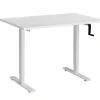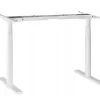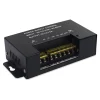Help Center: Projectors
What is a projector used for?
Projectors are devices that display images onto any surface—such as a retractable screen or wall—and can successfully replace traditional displays like monitors and TVs. They offer comparable image quality with much greater layout flexibility. Many also feature a range of conveniences and applications, allowing them to operate as standalone devices that can connect to the network and other devices both wired and wirelessly.
How does a projector work?
A projector displays images onto any surface by drawing from an external source such as a computer, DVD player, or home theater system. It uses a light source, like an LED, and an optical system to properly project images. There are two types of projectors: LCD and DLP. LCD projectors are equipped with a liquid crystal matrix that the light source passes through to display the image. Inside, three matrices are responsible for displaying primary colors: red, blue, and green. Devices using this technology offer clear images with vivid colors and uniform brightness. DLP projectors, however, contain a microprocessor and a special system of micromirrors that reflect the light stream from the lamp, providing soft colors and excellent contrast.
What parameters should you consider when choosing a projector?
When searching for a projector, you’ll encounter a wide range of devices with various parameters. Here are some key aspects to consider:
Resolution
For a clear and smooth image, focus on resolution. Higher resolutions offer better image quality, with HD or Full HD providing the best. However, devices with lower resolutions than HD are still adequate for office settings for presentations. Ultimately, the choice depends on user preferences and the device’s intended use.
Brightness
As important as resolution, the brightness of the lamp ensures clear images regardless of room lighting conditions. Higher brightness is better for rooms with poor dimming. For movie watching in dark rooms or at night, consider a lower brightness to ensure comfortable visual experiences. Brightness is measured in lumens or ANSI lumens, which provide an idea of how much light the device can emit.
Contrast
This parameter is crucial for the colors of the displayed image. Higher contrast results in more vibrant and appealing colors, especially important for watching movies as it significantly affects image perception.
What can a projector be connected to?
Projectors come with a variety of connectors, allowing for a wide range of device connections. Many projectors have AV, VGA, and HDMI ports, enabling connections to monitors, game consoles, or TV decoders. Often equipped with USB ports, they can work with any data storage device, like USB drives or external disks. Additionally, a USB port can connect a wireless mouse or keyboard for easier projector control. Some projectors also have a LAN port for internet connectivity, and a 3.5 mm audio output allows for the connection of headphones or speakers.
What are the types of projectors?
Projectors can be categorized by size and application into stationary and portable, mobile projectors. Stationary projectors, the most common type, are typically rectangular and used in offices or schools for presentations and at home for watching movies. They are designed to be set up in a convenient location. Portable projectors are compact and much smaller than stationary ones, making them easy to carry. They usually have an oval shape or resemble a long cube. They come with a high-capacity battery, usually lasting 3-4 hours of wireless operation, making them ideal for travel and outdoor movie sessions.
What are the differences between lumens and ANSI lumens?
A lumen is an SI unit of luminous flux, describing the amount of light emitted from a source, such as a bulb, LED, or other device. For projectors, a higher lumen value indicates a brighter image. ANSI lumens, standardized by ANSI in 1992, consider various factors like contrast and brightness, providing a more accurate measure than standard lumens. This is an important parameter when choosing a projector.










